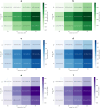Potassium silicate and vinasse enhance biometric characteristics of perennial sweet pepper (Capsicum annuum) under greenhouse conditions
- PMID: 38755228
- PMCID: PMC11099072
- DOI: 10.1038/s41598-024-61454-z
Potassium silicate and vinasse enhance biometric characteristics of perennial sweet pepper (Capsicum annuum) under greenhouse conditions
Abstract
An effective strategy for enhancing fruit production continuity during extended sweet pepper season involves adopting innovative biostimulants such as potassium silicate (PS) and vinasse. Adjusting PS and vinasse concentrations are crucial for maintaining the balance between vegetative and fruit growth, particularly in sweet pepper with a shallow root system, to sustain fruiting over prolonged season. However, the interaction between PS and vinasse and the underlying physiological mechanisms that extend the sweet pepper season under greenhouse conditions remain unclear. This study aimed to investigate the impact of PS and vinasse treatments on the yield and biochemical constituents of perennial pepper plants cultivated under greenhouse conditions. For two consecutive seasons [2018/2019 and 2019/2020], pepper plants were sprayed with PS (0, 0.5, and 1 g/l) and drenched with vinasse (0, 1, 2, and 3 l/m3). To estimate the impact of PS and vinasse on the growth, yield, and biochemical constituents of pepper plants, fresh and dry biomass, potential fruit yield, and some biochemical constituents were evaluated. Results revealed that PS (0.5 g/l) coupled with vinasse (3 l/m3) generated the most remarkable enhancement, in terms of plant biomass, total leaf area, total yield, and fruit weight during both growing seasons. The implementation of vinasse at 3 l/m3 with PS at 0.5 and 1 g/l demonstrated the most pronounced augmentation in leaf contents (chlorophyll index, nitrogen and potassium), alongside improved fruit quality, including total soluble solid and ascorbic acid contents, of extended sweet pepper season. By implementing the optimal combination of PS and vinasse, growers can significantly enhance the biomass production while maintaining a balance in fruiting, thereby maximizing the prolonged fruit production of superior sweet pepper under greenhouse conditions.
Keywords: Capsicum annuum; Condensed molasses soluble; Greenhouse; Potassium silicate; Sweet pepper; Vinasse.
© 2024. The Author(s).
Conflict of interest statement
The authors declare no competing interests.
Figures







References
-
- Zhang F, et al. Innovative nitrogen management strategy reduced N2O emission while maintaining high pepper yield in subtropical condition. Agr. Ecosyst. Environ. 2023;354:108565. doi: 10.1016/j.agee.2023.108565. - DOI
-
- Franczuk J, et al. The effect of mycorrhiza fungi and various mineral fertilizer levels on the growth, yield, and nutritional value of sweet pepper (Capsicum annuum L.) Agriculture. 2023;13:857. doi: 10.3390/agriculture13040857. - DOI
-
- Piñero MC, et al. Tailored physicochemical properties and bioactive value of sweet pepper fruits from controlled high temperature. Horticulturae. 2022;8:582. doi: 10.3390/horticulturae8070582. - DOI
-
- FAO. Statistical yearbook. Food and agriculture organization (FAO). http://faostat3.fao.org. Accessed 1 Dec, 2022.
-
- ATB. Annual bulletin of statical crop area and plant production 2018/2019, pepper. Central Agency for Puplic Mobilization and Statistics, 71–22122–2020 (2022).
MeSH terms
LinkOut - more resources
Full Text Sources

